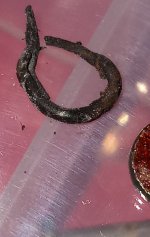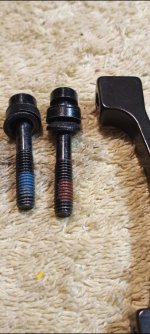I checked my brakes again and took some pictures,..
An O_ring needs a flat surface to seal...
It turns out that the caliper spacer is countersunk, so there is actually a flat surface that could do some sealing and accommodate an o-ring,..
Wonder if it's being used a spacer to keep a thinner bolt centered in an oversized spacer hole... a factory hack solution.
I don't think that's it?
The spacer hole is only a smidgen bigger than the bolt.
The caliper itself has slotted mounting holes to allow for alignment,..
Is there a lip the O_ring is sitting on or is the hole in the spacer the same top to bottom?
I'm figuring that the spacer hole has to be a smidgen bigger than the bolt to allow for a different alignment when using the spacer?
I installed new air forks that were built for 180 mm rotors, so I didn't need the spacer and had to buy shorter caliper bolts to mount my caliper to the new forks,..
The original caliper bolts have those saucer shaped cone washers to allow for a slightly different alignment angle caused by the spacer being taller at one end than the other,..
I remembered
@m@Robertson talking to
@Nvreloader about those things, and how shitty/stupid they are, so I deleted them from my front caliper figuring that things should line up fine without the spacer?
... or as
@PedalUma says just to hold the assembly together..
I think that's it?
They just hold the bolt, washers, caliper, and spacer together to keep things from falling apart when things are assembled.
But even then wouldn't it be at the bottom of the spacer stack?
The o-rings go here, and actually work to hold everything together.
When you unbolt the caliper, the bolt doesn't fall out so it's all held together.
Again... Never seen this ever... and I recently disassembled a new bike and there were no O_ring nor the clearance for one as in your pic
I removed the o-rings from both calipers, but I think that I'm going to remove those cone/saucer washers too.
They cause more trouble than they're worth.
The regular flat washer should be enough.
My bolt alignment might be off by 0.001° or something, but it's still better than the alignment issues that the cup and cones cause.
My caliper bolts will thread in farther, but the threaded holes in the frame go all the way through,..

